
Features
Business
Grower Profiles
Growing with the grid: Great Northern optimizing cogen setup as an industry option
June 9, 2008 By Dave Harrison
The Canadian greenhouse industry
has long been known for its culture of innovation. Yields improve every
year. Niche market opportunities are developed. Fine-tuning, trialling
and optimizing are constants.
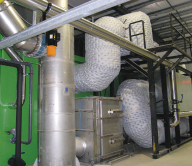 |
| One of the flue gas scrubbers; (bottom) president Darrin Didychuk and general manager Guido van het Hof. |
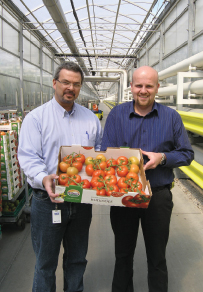 |
The Canadian greenhouse industry has long been known for its culture of innovation. Yields improve every year. Niche market opportunities are developed. Fine-tuning, trialling and optimizing are constants.
A good case in point is Great Northern Hydroponics, a 55-acre greenhouse tomato operation in Kingsville, Ontario. It has completed a number of innovative projects over the past few years. As just a few examples:
Faced with shortages of predators to control whitefly, it worked to establish its own dicyphus colony. It’s now self-sufficient with them.
It has worked with the American Institute of Baking (AIB) on food safety certification for the past seven years, receiving a superior rating the past five years in succession.
It is the only greenhouse operation in North America that is ISO 9001-2000 certified. (See sidebar story.)
Those projects by themselves would draw considerable attention, both at home and abroad. But it’s been the installation of its state-of-the-art, 12-megawatt cogeneration system that has the North American industry talking.
ONTARIO POWER AUTHORITY’S REQUEST FOR PROPOSALS
In 2006, the Ontario Power Authority issued a Request For Proposals to add some 1,000 megawatts of cogeneration power to the local grid. Great Northern Hydroponics lobbied to have greenhouses qualify under the district-heating component, and its application was approved.
It’s a win-win situation. The province gets a clean and reliable electricity source, while Great Northern Hydroponics gets the heat and CO2, along with the ability to buy electricity minus the usual transportation costs. By utilizing the CO2, the project will qualify as a carbon sink.
But first a little background. Great Northern Hydroponics began studying its energy options about four years ago. Fossil fuel prices were rising and consuming a larger share of its costs of production. “We saw the economics of our industry changing in terms of foreign exchange rates and energy costs,” recalled company president Darrin Didychuk. “We began looking at the available technologies worldwide.”
General manager Guido van het Hof said controlling energy costs has been a continuing challenge. “Each year, we have been able to tweak the costs a little.” Last year, for example, temperature integration modelling was introduced, substantially cutting heating costs by $400,000.
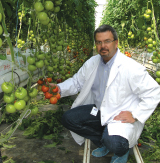 |
| Darrin Didychuk takes a closer look at a cluster |
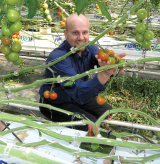 |
| General manager Guido van het Hof always keeps a close eye on the crops. |
“SOMETHING TO TAKE US FORWARD 20 YEARS,
NOT BACK 20 YEARS”
The management team looked at alternatives, including biomass and coal, but weren’t convinced any of these fuels offered a long-term solution. “We wanted something to take us forward 20 years, not back 20 years,” said Didychuk. “And we had to determine what was sustainable, not just for our cost containment, but also for the environment.”
The focus soon turned to cogeneration. Their research narrowed to GE Energy in the Netherlands, and its Jenbacher CO2 fertilization cogeneration system.
Not long after they began talking with GE Energy, the OPA program was announced. It was perfect timing.
Great Northern Hydroponics soon began working with GE/Jenbacher on preparing its OPA application. The teamwork paid off. “We knew the program was a perfect fit for the greenhouse industry,” said Didychuk.
Construction on the power plant to house the four, three-megawatt engines began in May 2007. Also included were heat recovery and exhaust treatment equipment, noise abatement insulation, and systems controls. Work was completed earlier this year.
Environmentally, it’s a low-impact project. Key to its low emissions are the high-tech scrubbers. “All the harmful contaminants have been eliminated from the emissions,” said Didychuk. Just about all that’s left is water vapour and CO2.
Producing 12 MW of electricity with ultra-low emissions is quite impressive. Not many electrical generating power plants utilize their CO2 emissions – usually considered a negative byproduct – to help grow food.
“We’re hoping our energy efficiencies will approach 97 or 98 per cent,” said Didychuk. “That would be very energy efficient and quite environmentally friendly.”
Energy optimization doesn’t stop there. “Once we get this model running, we may even be able to apply the energy for cooling our warehouse.”
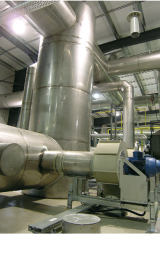 |
| Part of the CO2 exhaust gas manifold system. |
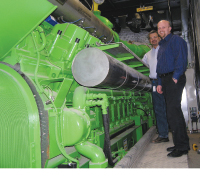 |
| Darrin Didychuk and Guido van het Hof, with one of the four 3-MW Jenbacher gas engines utilized at Great Northern Hydroponics. |
EUROPEAN TECHNOLOGY FINE-TUNED FOR NORTH AMERICA
GE/Jenbacher has applied its highly touted European technology to the project, while fine-tuning it for North American needs. “There are a couple of unique things we’re doing here that they haven’t done before,” Didychuk explained.
The company will still rely on traditional boilers for some of its heating requirements during the coldest winter months. That’s because the cogen system was sized for the company’s CO2 needs, and not specifically for its heating requirements. It will still supply about 75 per cent of Great Northern’s heating requirements. Additional units can be added since the infrastructure was designed for 18 megawatts.
Industry reaction has been quite positive. Interest has been expressed from as far away as British Columbia and Mexico. “Everyone is looking at this as being a very positive technology. We see this as the leading energy solution for the greenhouse industry, and particularly for the vegetable sector,” said Didychuk.
It’s expected the payback period for the $20-million project will be less than five years. The company has a 20-year electricity supply contract with the Ontario government.
NEW COMPANY WORKING TO MARKET THE SYSTEM
Expertise gained from the project has led to the start-up of Eco Gen
Power Systems, a stand-alone company to market the system. Great
Northern Hydroponics is working with GE/Jenbacher “to roll this
(technology) to other greenhouses,” said Didychuk, who also serves as
president of this new company.
An approval process has been developed that will allow them to submit
bids on similar OPA gas-fired, clean energy program opportunities.
Several bids are already in the design stage throughout Ontario. If
those applications are green-lighted by the OPA, the new projects could
be operational within the next year or so. “There are tremendous
benefits to the province in terms of new supplies of electricity
combined with CO2 abatement,” said Didychuk.
The technology would work just as well for smaller greenhouses. “Ours
is a large project, even by European greenhouse standards,” he
explained. “But it’s also a very modular system.”
| IS0 9001-2000: incorporating best management techniques Among the earlier cost-saving initiatives, the work by Great Northern Hydroponics towards ISO 9001-2000 certification has paid major dividends, according to general manager Guido van het Hof. The program requires a painstakingly thorough review of everything a company does. “It basically means you take the entire company apart and put it back together, piece by piece, using the best management practices that you can find,” he said. “At the same time, you’re shaking out all the inefficiencies you find along the way.” Great Northern Hydroponics has always been an efficient operation. And yet the ISO 9001-2000 process still found room for improvement. Company president Darrin Didychuk said the process was extremely rewarding. “In that first year we were fully certified and all the best management practices were in place, we eliminated $600,000 in costs. It was amazing.” Van het Hoff said they achieved a 25 to 30 per cent reduction in their maintenance budget alone. This was largely due to a move towards more preventive maintenance work. Machinery is overhauled before “it has a chance to break,” he explains. “It’s much cheaper than waiting until it breaks, and then having to fix it.” |
It’s also quite versatile. One potential project would involve three greenhouse operations tied into a single power plant.
The North American greenhouse industry represents a major opportunity for GE Energy. “The project is an important one for GE Energy, as it represents the first Jenbacher CO2 fertilization cogeneration system to be installed in North America,” according to Prady Iyyanki, CEO of GE Energy’s Jenbacher gas engine unit. While this is a common application in the Netherlands, the Great Northern Hydroponics plant “will serve as an important reference for our customers in North America.”
Print this page